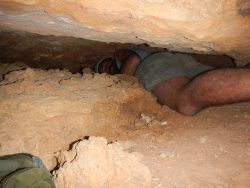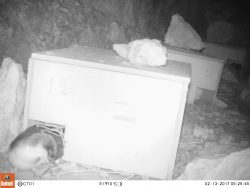Yelkouan Shearwaters have now left their colonies around the Maltese Islands, bringing our 2017 field season at LIFE Arċipelagu Garnija almost to an end, but what a season it has been! While we have been studying several aspects of the secretive lives of these seabirds, one in particular, namely reproductive success, is important to understand how the population is actually faring. Low reproductive success in Yelkouan Shearwaters is in fact given as one of the reasons for population decline and uplisting to “vulnerable” on the IUCN Red List.
At least three visits were made to each colony with known nests. At the start of the season to confirm that an egg had been laid in each nest, mid-season to check if the egg hatched and a final visit to confirm that the nestling made it to fledging stage – that is ready to leave the nest and fly out to the open ocean. In this way two figures of success rate are obtained: one for hatching and one for fledging.

Jørgen Sand Sæbø, volunteering with the project, checks a Yelkouan Shearwater nest deep inside a cave on Cominotto
Still, nest monitoring is more easily said than done, especially with a species that nests in deep cracks within the cliffs. To view a nest we often have to crawl through narrow tunnels, where we just manage to squeeze through, and then twisting our necks to check the nest contents while at the same time trying not to breathe in too much dust from the burrow floor. When we do manage to see our reward in the form of an incubating adult or healthy nestling, we can crawl back out with a smile. Unfortunately this is not always the case, and we are too often met with a sad sight of either eaten eggs or lifeless remains of nestlings, the culprit being rats.
When possible we ringed the young birds with a standardised metal ring around the leg, each ring inscribed with a unique number. This gives exciting information about when and where the birds return to a colony if recaptured in the future. This season we managed to ring 110 Yelkouan Shearwater nestlings and fledglings giving a good sample for future recaptures. This, plus last year’s data is crucial to acquire knowledge on how Yelkouan Shearwaters cope with nesting in colonies without predator and human disturbance control. This can also be compared to the good reproductive success at L-Irdum tal-Madonna where predator control has been going on for around 10 years. After beginning to implement conservation and public awareness actions by 2018 we hope that we will log a higher success rate in more colonies.
Finally, in an attempt to increase the sample of accessible nests we can more easily monitor, in autumn 2016 we installed over 60 nest boxes in different colonies. The first Yelkouan pair to use one did not take long! Just a few months later, a pair were observed taking in nesting material and shortly after incubating an egg. The success does not end there, just two weeks ago when we last checked the nest box, the young bird which had been growing well after hatching, had left the box. We wish it a safe journey out at sea and hope for its return in a few years, maybe to occupy a neighbouring nest box of its own.
By Martin Austad, Project Warden

